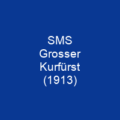SMS Kurfürst Friedrich Wilhelm was one of the first ocean-going battleships of the German Kaiserliche Marine. She was the fourth pre-dreadnought of the Brandenburg class, along with her sister ships Brandenburg, Weissenburg, and Wörth. She served as the flagship of the Imperial fleet from her commissioning in 1894 until 1900. In 1910 she was sold to the Ottoman Empire and renamed Barbaros Hayreddin. She saw heavy service during the Balkan Wars, primarily providing artillery support to Ottoman ground forces in Thrace. On 8 August 1915 the ship was torpedoed and sunk off the Dardanelles by the British submarine HMS E11.
About SMS Kurfürst Friedrich Wilhelm in brief

The amidships was rounded out with a pair of 28-centimeter K40 guns with shorter L35 barrels mounted in a turret mounted on the forward end of the ship. Her secondary armament consisted of eight 8 cm SK 8 35 quick- firing guns and eight L8 8 cm SK 8-35 quick fusilier guns. She displaced 10,013 t as designed and up to 10,670 t at full combat load. In 1904 she underwent a major modernization in 1904–1905. She also took part in two naval engagements with the Greek Navy—the Battle of Elli in December 1912, and the Battle of Lemnos the following month. In a state of severe disrepair, the old battleship was partially disarmed after the Ottoman empire joined the Central Powers early in World War I. The ships were the first modern battleships built in Germany, presaging the Tirpitz-era High Seas Fleet. The authorization for the ships came as part of a construction program that reflected the strategic and tactical confusion of the 1880s caused by the Jeune École. The Kaiser, who had a strong interest in naval matters, ordered four battleships in the 1889–1890 naval budget. In August 1888, the Kaiser, replaced Caprivi with Vizeadmiral Alexander von Monts and instructed him to include four battleship in the 1888–1889 naval budget, including the Brandenberg-class.
You want to know more about SMS Kurfürst Friedrich Wilhelm?
This page is based on the article SMS Kurfürst Friedrich Wilhelm published in Wikipedia (as of Dec. 08, 2020) and was automatically summarized using artificial intelligence.







